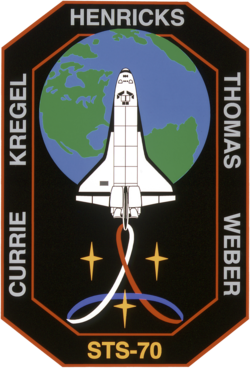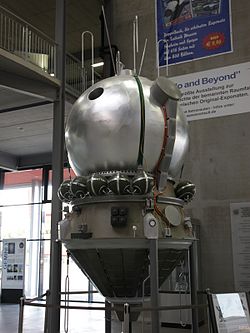STS-69
| STS-69 | |||||
 | |||||
| Uppdrag | 71 | ||||
|---|---|---|---|---|---|
| Rymdfärja | Endeavour (9)[1] | ||||
| NSSDC-ID | 1995-048A[2] | ||||
| Färdens tid | 10 dagar, 20 timmar, 29 minuter, 56 sekunder | ||||
| Uppskjutning | |||||
| Startplats | Startplatta 39A vid Kennedy Space Center i Florida | ||||
| Start | 7 september 1995, 15:09:00 UTC | ||||
| Landning | |||||
| Landningsplats | KSC runway 33 | ||||
| Landning | 18 september 1995, 11:38:56 UTC | ||||
| Omloppsbana | |||||
| Varv | 170 st[3] | ||||
| Apogeum | 321 km | ||||
| Perigeum | 321 km | ||||
| Banlutning | 28,45° | ||||
| Sträcka | 7,2 miljoner km | ||||
| Rymdpromenad | |||||
| Antal | 1 st | ||||
| Total tid | 6 timmar, 46 minuter | ||||
| Besättning | |||||
| Befälhavare | David M. Walker (4) | ||||
| Pilot | Kenneth D. Cockrell (2) | ||||
| Uppdragsspecialister | James H. Newman Ph.D.(2) Michael L. Gernhardt (1) | ||||
| Nyttolastspecialister | James S. Voss (3) | ||||
 | |||||
| Kronologi Rymdfärjeprogrammet | |||||
| |||||
STS-69 var ett rymdfärjeuppdrag som genomfördes 1995 med rymdfärjan Endeavour. Den sköts upp från Pad 39B vid Kennedy Space Center i Florida den 7 september 1995. Efter nästan elva dagar i omloppsbana runt jorden återinträdde rymdfärjan i jordens atmosfär och landade vid Kennedy Space Center.
Se även
Referenser
- ^ NASA Space Shuttle Launch Archive Arkiverad 29 mars 2015 hämtat från the Wayback Machine., läst 28 juli 2016.
- ^ ”NASA Space Science Data Coordinated Archive” (på engelska). NASA. https://nssdc.gsfc.nasa.gov/nmc/spacecraft/display.action?id=1995-048A. Läst 20 mars 2020.
- ^ Manned Astronautics - Figures & Facts Arkiverad 4 mars 2016 hämtat från the Wayback Machine., läst 28 juli 2016.
Externa länkar
 Wikimedia Commons har media som rör STS-69.
Wikimedia Commons har media som rör STS-69.
| ||||||||
| ||||||||||||||||||||||||||||||||
Media som används på denna webbplats
The crew patch of STS-73, the second flight of the United States Microgravity Laboratory (USML-2), depicts the Space Shuttle Columbia in the vastness of space. In the foreground are the classic regular polyhedrons that were investigated by Plato and later Euclid. The Pythagoreans were also fascinated by the symmetrical three-dimensional objects whose sides are the same regular polygon. The tetrahedron, the cube, the octahedron, and the icosahedron were each associated with the Natural Elements of that time: fire (on this mission represented as combustion science); Earth (crystallography), air and water (fluid physics). An additional icon shown as the infinity symbol was added to further convey the discipline of fluid mechanics. The shape of the emblem represents a fifth polyhedron, a dodecahedron, which the Pythagoreans thought corresponded to a fifth element that represented the cosmos.
STS-70 Mission Insignia
The STS-70 crew patch depicts the Space Shuttle Discovery orbiting Earth in the vast blackness of space. The primary mission of deploying a NASA Tracking and Data Relay Satellite (TDRS) is depicted by three gold stars. They represent the triad composed of spacecraft transmitting data to Earth through the TDRS system. The stylized red, white, and blue ribbon represents the American goal of linking space exploration to the advancement of all humankind.
Författare/Upphovsman: Pascal (Flickr user: pasukaru76), Licens: CC0
Vostok spacecraft replica at the Technik Museum Speyer, Germany.
Crew of the Space Shuttle mission STS-69. NASA photo STS069-S-002. David M. Walker (right front) mission commander; with Kenneth D. Cockrell (left front) pilot. On the back row are (left to right) Michael L. Gernhardt and James H. Newman, both mission specialists; and James S. Voss, payload commander.
STS-69 Mission Insignia







